 |
 | |
 |
| |
What sort of people will buy my product? Should
I make a TV ad? Or could I get people’s attention
by sponsoring an event? It costs a lot to sell something
new.
|
|
|
 |
| |
Developers
and designers must have an idea of the target market for
their product as they work. To find out what buyers really
want, market research is usually needed. Surveys or discussion
groups allow researchers to test ideas about the product
with potential buyers. As the product is being developed,
early surveys or models can test customer reaction to
potential designs and help refine the product before it
reaches the marketplace.
A marketing campaign can start before a product is available.
Computer generated images or models can be used in print
advertising, and radio interviews can be used to ‘talk
up’ the product and build up interest. Production
and distribution networks must be ready when people want
to buy the product.
Knowing who the customers are helps marketers choose where
to sell the product and how best to advertise it. It also
assists in selecting people to endorse the product.
Distribution agents must be trained and supported in their
efforts to promote and sell the product. This can include
point-of-sale advertising provided by the company. The
Internet has become an important medium for getting information
to potential customers and for selling products.
Marketing of technical and industrial products http://www.robertwinton.com/contents.htm
|
|

|
| |
Victa
– how it became Australia’s number 1 mower
Mervyn Victor Richardson developed the Victa rotary lawn-mower
in August 1952. It was not the first rotary lawn-mower
ever developed, but it was cheaper, lighter and easier
to use than the mowers that came before.
Mervyn advertised his new mowers and sold them from his
home. Demand for the mowers was high with the growth of
post-war suburbia. Soon Mervyn had to expand the business
to a new location and Victa Mowers Pty Ltd was born.
From the early days Victa effectively used marketing to
promote and sell its mowers. It pioneered TV advertising
in Australia, using celebrity endorsements and combining
them with extensive newspaper and print media campaigns.
Victa set up a network of distributors and trained them
in promotion and sales.
Within two years of setting up the business, Victa had
sold 20 000 mowers and was beginning to export them. The
company continued to improve the technology, design and
marketing of its products by responding to customers’
needs. By 2002, after almost 50 years of operation, 6.5
million Victa mowers had been sold in 30 countries around
the world.
|
|
 |
 |
| |
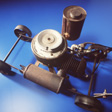 |
| The peach-tin prototype. Powerhouse
Museum. Photo by Sue Stafford. |
|
|
Introduction
— developing the Victa
While the Victa rotary lawn-mower was not the first of
its kind, the light weight and ease of manufacture were
innovative. A British patent for a rotary lawn-mower exists
from 1932, and Lawrence Hall built a rotary lawn-mower
in Sydney in 1948.
The ‘Mowhall’ rotary mower developed by Lawrence
Hall was made from a heavy plough disc and marine engine.
It required two people (one to push and one to pull) and
was never a great commercial success. Mervyn Victor Richardson
saw the ‘Mowhall’ being demonstrated in 1948.
In 1949 when Mervyn’s son, Gary, started a mowing
business, Mervyn decided to build two lawn-mowers for
Gary to use. The mowers used imported Villiers two-stroke
engines with a traditional horizontal rotating reel. Mervyn
continued to build and sell these mowers after the mowing
business was closed.
In August 1952, Mervyn had the idea to put one of the
engines on its side to drive a blade rotating in a horizontal
plane. He assembled a prototype from a few scraps of metal
and a peach tin for a fuel can. The prototype was tested
and worked – it cut fine grass, long grass and weeds.
Mervyn then began selling his new mower. He called it
the Victa Rotomo 18 and advertised demonstrations at his
own home. Within three months he had sold 30 mowers. On
13 February 1953 Victa Mowers Pty Ltd was formed. The
company expanded, moved location and by 1958 had 3000
employees building 143 000 mowers a year for export to
28 countries.
Of great importance in the rapid initial success of the
Victa mower was the innovative promotional methods used.
Victa quickly found a niche in the market and established
its name as a supplier of reliable, affordable mowers.
|
|
|
| |
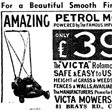 |
| The first Victa mower newspaper
advertisement. September 1952 – February 1953.
From Powerhouse Museum Victa Archive. Courtesy of
Victa Sunbeam. |
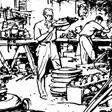 |
| A sketch of the shed at Mortlake showing production
of Victa mowers. Sketch by Robert Emerson Curtis. Courtesy
Victa. |
 |
| ‘Cutting grass is fun’ so this leaflet
from 1955 says. From Powerhouse Museum Victa Archive.
Courtesy of Victa. |
|
|
The beginnings of marketing and promotion
When Mervyn first developed his Victa mower, his most
successful sales technique was direct demonstration. Over
the summer of 1952 – 53 he demonstrated the mower
at his own home. He and his family made the mowers in
their garage. Mervyn placed a newspaper advertisement
encouraging customers to visit his home and see the mower
in action.
The advertisement resulted in an astonishing demand for
the lightweight lawn-mower that could turn what had once
been pasture or bush into civilised, elegant lawn. Soon
Mervyn could not keep up with the demand. He gave up his
old job to become full time manager of the business and
moved the company to a shed in Mortlake.
Victa continued to advertise in newspapers and radio,
and the demonstrations continued to sell the mowers. The
mower was advertised as ‘new’, ‘reliable’
and ‘revolutionary’. There was ‘no lawn
too fine, no growth too tough’.
Some customers used the mowers for tasks that weren’t
in the instruction manual: to cut down trees; power small
boats; or cut gravel. Victa welcomed the surprising and
unique publicity this brought.
|
|
|
| |
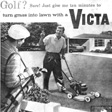 |
| A newspaper advertisement from 1960 promoting
the leisure opportunities the Victa could provide. From
Powerhouse Museum Victa Archive. Courtesy of Victa |
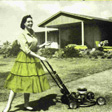 |
| The Victa could ‘Cut fine lawns to perfection
and eat through TOUGH jungle growth’ in this leaflet
from 1957. In early advertisements well-dressed women
were mowing the lawn with a Victa – it was so easy
to use! From Powerhouse Museum Victa Archive. Courtesy
of Victa Sunbeam. |
|
|
The
first big campaign
In 1958 the company moved to a new factory and developed
a five-year plan. It wanted to make the best product on
the market, be the first into volume production and distribution,
and base the business on a low-price mower that a middle-income
family could afford. It established a network of over
900 dealers around the country to promote and sell the
Victa lawn-mower.
At the same time Victa began a major advertising campaign
to promote the Victa lawn-mower and name. The company
used an all-media approach. It ran two-page advertisements
in national weekend papers. Its radio campaign covered
all states and used a catchy jingle. Victa pioneered the
use of television advertising in both Sydney and Melbourne.
A two-minute film called ‘Mowing Places with Victa’
was distributed to cinemas around the country.
Up until this time, Victa’s advertising had focussed
on the ease of use and functional abilities of the mower.
The company promoted the mower as being able to cut any
height of grass and weeds and cut right up to fences and
walls. The campaign of 1958 – 59 continued to highlight
these features, but also promoted the mower as a labour-saving
device.
Slogans such as ‘Don’t be the last man on your
street to own a Victa’ and ‘Summer weekends
are too precious to waste’ encouraged homeowners
to ‘have the kind of smooth, trim lawn everyone admires’
without sacrificing hours of the weekend. Promotional
feature supplements were inserted in major national newspapers
to inform people about lawns, how to care for them and,
of course, which was the best mower to do the job!
|
|
|
| |
 |
| A leaflet from 1960 showing early use of the
‘turns grass into lawn’ slogan. From Powerhouse
Museum Victa Archive. Courtesy of Victa. |
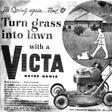 |
| This newspaper advertisement
from spring 1960 says that ‘Grass is growing…
think of mowing.’ The peak mower season was
approaching. From Powerhouse Museum Victa Archive.
Courtesy of Victa. |
|
|
Turning
grass into lawn…
It was during 1959 that the slogans ‘turns grass
into lawn’ and ‘Australia’s top selling
mower’ were introduced. These slogans featured in
much of Victa’s advertising for the next 40 years.
The active print media campaign promoted Victa as Australia’s
favourite. In January 1959 the public were told that ‘over
250 000 Australian families turn grass into lawn with
Victa mowers’.
The Victa mower was promoted as an essential ingredient
for a relaxing weekend. There were ‘over three hundred
and seventy five thousand families using Victa to bring
extra hours of weekend leisure’. Families were even
encouraged to buy Dad one for Christmas and help him cut
that ‘laborious mowing marathon into a stroll’.
A useful public relations exercise for Victa during this
time was its community mowing section that provided services
to charitable organisations. Victa staff visited schools,
churches, cemeteries and other sites, mowing and looking
after the lawn for free. This activity gave Victa free
publicity in local newspapers and raised the profile of
the company within the community.
Russell Jennings, the advertising manager of Victa at
the time, treated lawn-mower sales as a seasonal business.
He adjusted the campaign according to the peak ‘mower
season’ in different states. After a couple of days’
heavy rain followed by humid weather, sales increased
as the grass grew rapidly. Dry spells, of course, subdued
demand.
Jennings considered the day of the week as an important
factor in achieving maximum impact for Victa advertisements.
He concentrated advertising at the end of the week and
the weekend ‘to catch the man with a lawn during
his most receptive periods – while he is contemplating
with little enthusiasm the chore of cutting the grass
with a hand mower, or just after he has done it in this
laborious manner’.
The network of Victa agents around the country promoted
the mower using point-of-sale brochures, posters and other
literature. These dealers also advertised the Victa mower
as part of their own press advertising campaigns. In 1959
the company’s total sales rose to 142 909.
Continuing innovation
Victa introduced more innovations to the basic lightweight
mower including height adjustment, automatic zip coil
starting, folding handles, rear grass catcher, plastic
grass catcher, the world’s first plastic carburettor,
‘vortex’ noise reduction technologies and the
‘mulch and catch’ that could either catch or
return the grass to the lawn. These innovations were the
focus of media campaigns to promote new products. The
company also encouraged people to trade in their old models
for new ones by promoting the advantages of the new models
over the old.
|
|
|
| |
 |
| In this leaflet from 1970
‘Lawna Green’ encouraged dealers to prepare
for the upcoming February sales peak. From Powerhouse
Museum Victa Archive. Courtesy of Victa. |
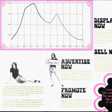 |
| Selling mowers has remained a seasonal business
as shown in this graph from the 1970 ‘Lawna Green’
dealers leaflet. From Powerhouse Museum Victa Archive.
Courtesy of Victa. |
 |
| The 2002 campaign promoted
50 years of Victa as a reliable, quality brand of
mowers. Courtesy of Victa. |
 |
| This logo was first used by
Victa in 1966 and was still in use in 2002. Courtesy
of Victa. |
|
|
Marketing
techniques used by Victa
Turing the first 50 years of selling the Victa lawn-mower,
there have been two main avenues for promoting the product:
media campaigns and promotion at the retail outlet.
Retail promotion
Since Mervyn Richardson set up Victa Mowers Pty Ltd, the
company has focussed much of its marketing efforts on
influencing what happens in the shops where people buy
mowers. In the beginning the company established a network
of retail outlets and agents. The dealers included a rainwater
tank maker, travel agent, picture theatre proprietor (who
apparently turned his chocolate counter into a Victa display!),
undertaker, barbershops and other diverse businesses.
They all provided service and spare parts to Victa’s
service standards.
Victa published booklets and other literature to inform
dealers about the products and encourage them to promote
Victa. The company provided creative ideas for ways to
promote the product. Dealers used these ideas and also
came up with their own unique ways of attracting customers
to buy Victa mowers from their store.
Victa offered price incentives and exclusive ranges to
encourage distributors to promote its products. By 2002
there were 500 specialists and 1000 retailers distributing
Victa mowers.
Media campaigns
When the Victa mower was first developed, media advertising
focussed on creating public awareness of the product.
The early TV and press advertisements promoted the functions
of the mower and its advantages over previous technology.
As the Victa mower became recognised in the marketplace,
advertising was used to promote new models and innovations.
Some campaigns focussed only on promoting the Victa brand,
such as ‘Victa knows Aussie lawns’.
Victa used all types of media as part of its campaigns.
The company pioneered TV advertising and used newspapers,
magazines, radio and cinema advertising. In 2001 Victa
began using the Internet to provide information to potential
and existing customers about its products and services.
Celebrities endorsing the Victa mower featured in campaigns
of the 60s and 70s. Cricket players and groundsmen from
Queensland and Victoria were used to give the company
a local identity in these states. Formula one racing driver
Allan Moffat and TV personality Noel Brophy featured in
a series of TV and print advertisements in the mid-1970s
as part of the Zip-Hip-Hooray campaign.
Each new product or innovation launched was accompanied
by a media campaign. The most recent campaign based on
a new product was the Mulch and Catch campaign in 1996
– 7. The new product was able to create mulch from
the cuttings and return it to the lawn, or catch the cuttings
in the grass catcher. The campaign used TV, gardening
magazines and general press promotion. For examples from
this campaign see http://www.metropolis.com.au/virtu/html/crident.html.
|
|
|
| |
 |
| Victa celebrated 50 years
in business in 2002 with the launch of a new model.
Courtesy of Victa. |
|
|
The
impacts
On 2002 Victa Mowers Pty Ltd celebrated its 50th anniversary.
The company that began in the backyard of the inventor
had grown to become an icon of a nation. Its iconic status
was cemented in history when it featured as part of the
opening ceremony of the Sydney 2000 Olympic Games.
By 2002, Victa’s total sales had reached 6.5 million.
The company had 75% of the Australian market share in
mulch and catch mowers and was also exporting mowers to
30 countries.
Since its backyard beginnings, Victa continually improved
its products in response to customers’ needs. The
marketing and promotion of these innovations was integral
to Victa’s success.
|
|
|
| |
Links and references
Victa Home http://www.victa.com.au
Victa poem http://www.victa.com.au/victapoem.html
Victa patent http://www.ipaustralia.gov.au/ip/examples/P_case6.htm
Sunbeam Australia http://www.sunbeam.com.au
GUD Holdings — Victa parent company http://www.gud.com.au/index.html
Advertising, January 1959, p. 36-37, Sydney.
Powerhouse Museum Victa Archives 94/1/59, P3646.
Key
people
Mervyn Victor Richardson – designer and entrepreneur
Russell Jennings – advertising manager for Victa
1950s-60s
Jobs
and skills
Engineer – design and development
Entrepreneur – create enthusiasm for and promote
the product
Marketer – make the product brand well recognised
and sell the product
Technical managers – oversee technical development
and manufacturing
Financial officer – control and advise on finances
Discussion
questions
K-6
1. Why is the lawn-mower called a ‘rotary mower’?
What fuel does the Victa use?
2. Look at the images used to advertise Victa mowers.
How was life when the Victa was invented different from
life now?
3. Collect pictures of people using lawns. What are the
different ways people use a lawn? Why do people like to
look after their lawn?
4. How was grass kept neat before the invention of the
lawn-mower?
7-10
1. Look at the advertising images over the years for Victa
lawn-mowers. Can you identify any themes, trends or stereotypes?
2. List five innovative features which were introduced
by Victa to later models of lawn-mowers.
3. Why do lawn-mowers sell better in Australia than in
most other countries?
4. Why could the Victa mower be considered an Australian
cultural icon? Discuss the inclusion of the Victa lawn-mower
in the Olympic Opening Ceremony celebrations and some
of the reasons it might be used in such a context.
11-12
1. Why does the marketing for a product such as Victa
mowers start before the product is made?
2. What is a ‘target market’ and how is this
market determined? Why is market research important? List
three methods used to gather information for market research.
3. Discuss some of the social, political, economic and
environmental issues which may make the notion of a backyard
or lawn important to Australians.
4. Conduct a needs analysis in your classroom or school.
How many people would find a lawn-mower a useful product
to own? And if so, what kinds of things would they be
looking for? Discuss some of your findings.
|
|
|
 |
  |
|
|
|
























